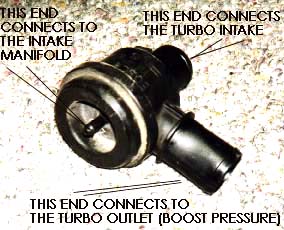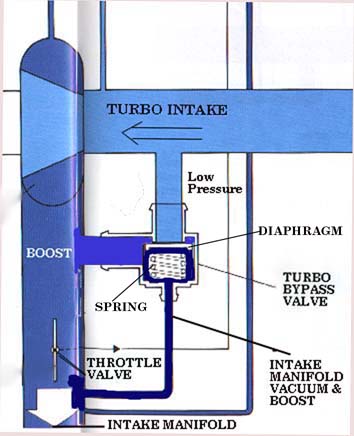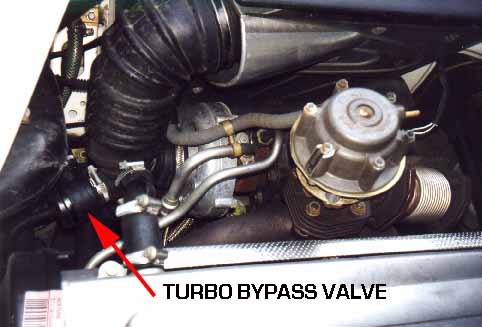

|
20V Motronic ECU System 1991 200TQ and 1992-95 S4/S6 with 20V Engine TURBO BYPASS VALVE (Also known as the Turbo Cut Off Valve) The Turbo Bypass valve allows air to recirculate around between the turbo intake and outlet during gear shifting and engine idling. The small hose connected to the Bypass valve is normally connected to the intake manifold and provides engine vacuum to open the valve during gear shifting (throttle closed) which allows the turbo to continue to spin and reduce turbo lag when you get back on the throttle [1]. It is important to understand that the Bypass valve will also be open when the engine is idling when no boost is produced. Both of the large hose connections on the Bypass valve must be connected, one to the turbo intake (low pressure) and one to the turbo exit (High pressure) as shown below.  If you leave the low pressure side open as in a dump valve installation, the valve will be open at idle and will create a false air leak that the fuel system Mass Air Flow (MAF) Hot wire unit will not measure. On the 1991 200TQ 20V, the small hose to the Bypass valve is routed behind the intake pipe heat shield and this hose often times falls apart due to the extreme heat. Remove the heat shield to check this hose. It is a good idea to reroute the hose near the fender area to avoid burning it up again. On the 1992-95 S4/S6, there is a short hose between the bypass valve and the metal pipe that runs behind the timing belt cover, then there is another short piece of hose where this pipe connects to the intake manifold. The Turbo Bypass valve often leaks due to a torn internal diaphragm. This happens on high mileage vehicles with the original valve installed, and after 1-2 years on vehicles running high boost. You can use a hand vacuum pump to apply vacuum to the small hose fitting and check for correct operation and see if the valve is leaking. If you remove the bypass valve you can also manually push the valve open and then hold your finger over the small fitting to see if the valve holds vacuum. If the diaphragm is leaking, you may lose boost pressure as the valve relies on the internal spring and boost pressure to hold the diaphragm closed. The important thing to understand is THE TURBO BYPASS VALVE REQUIRES BOOST FROM THE INTAKE MANIFOLD CONNECTED TO THIS SMALL FITTING ON THE BYPASS VALVE, TO HOLD IT CLOSED AS THE TURBO PRODUCES INCREASING BOOST. Here is a diagram of the valve installation showing the correct orientation of the connections to both the boost side and the turbo intake side.  Diagram courtesy of Audi AG Please note that the boost side of the Bypass valve connection is at a 90 angle to the small vacuum hose fitting. The Photo below shows the Turbo Bypass valve installed in the correct orientation on the 1992-95 S4/S6 vehicles with 20V Turbo engine.  20V ECU system information index References: [1] Audi of America, Technical service training publication: "The New 20V Turbo Engine for the Audi 200 Quattro-publication All rights reserved. Copyright © SJM Autotechnik™ , all rights reserved Return to Troubleshooting Tips page. Return to SJM Autotechnik™ main page. |
| About Us Privacy Policy Terms of Use Links Customer Service Safety Information Home |